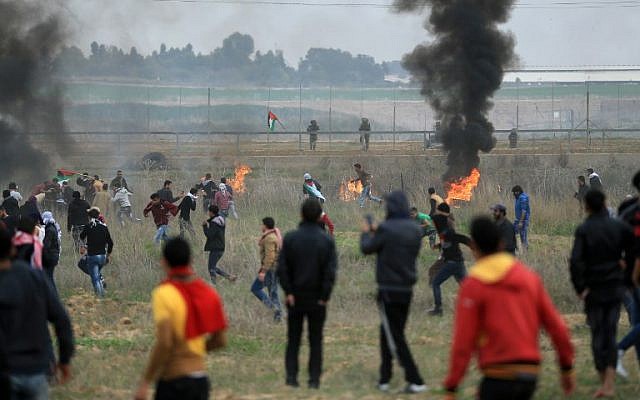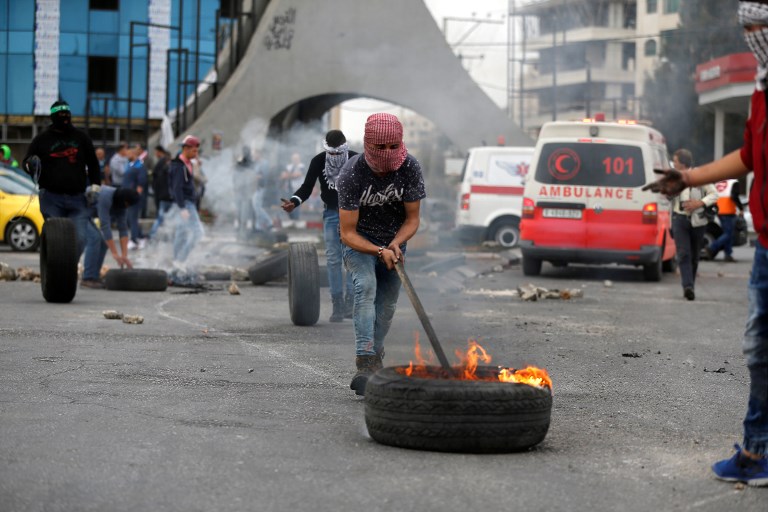Two Palestinian protesters were reported killed during violent demonstrations along the Gaza Strip’s security fence on Friday, as thousands more took part in riots in the coastal enclave and across the West Bank for the third straight week following US President Donald Trump’s recognition of Jerusalem as Israel’s capital.
“Zakaria al-Kafarneh, 24, died after being shot in the chest east of Jabaliya (in northern Gaza),” a Gaza health ministry spokesman said in a statement. There was no immediate information on the second person’s identity.The army confirmed that live rounds had been fired at what it called “main instigators,” during the protest. “A hit was confirmed,” the army spokesperson said.
The Gaza health ministry, which is run by terror group Hamas, said that five or six other Palestinian rioters were shot with live ammunition.
The protests along the Gaza security fence took place in three main locations: Jabaliya, Khan Younis and Gaza City.
According to the IDF, some 2,000 people took part in the protests, throwing rocks and rollings burning tires at the fence and the soldiers on the other side.
According to the military, approximately 1,700 Palestinians also took part in protests across the West Bank, a decrease from the number that participated last Friday — approximately 2,500 — and significantly fewer than the week before — nearly 10,000.
During the violent demonstrations in the West Bank, protesters threw rocks and rolled burning tires at IDF troops, who responded with less-lethal riot dispersal weapons, like tear gas, rubber bullets and stun grenades.
Border Police officers also fired live rounds at some protests in the West Bank. IDF troops did not, according to an army spokesperson.
The Palestinian Red Crescent reported that four Palestinian protesters were hit by live fire, one each in Qalandiya and Ramallah and two more outside Nablus. Approximately two dozen rioters were injured by Israeli rubber bullets, most of them in Hawara in the northern West Bank. A few dozen others were also treated after they inhaled tear gas.


The largest riot took place on the outskirts of Ramallah, where last week a Palestinian wearing what appeared to be a suicide bomb belt — but was actually a dud — stabbed a Border Police officer in the upper body, moderately wounding him. The assailant was shot by other officers on the scene and was later pronounced dead of his wounds by Palestinian medics.
Smaller protests took place in Hebron, Bethlehem, Nablus, Hawara, Qalqiliya and Qalandiya.
Low-level scuffles between Palestinians and Border Police officers were reported in the Old City of Jerusalem as well.
On Thursday, Hamas’s Gaza chief Yahya Sinwar, in a rare televised address, called for Friday to be a “red bloody day,” following the day’s United Nations General Assembly vote against Trump’s recognition of Jerusalem as Israel’s capital.
Sinwar called on “the people of Jerusalem, the West Bank and the Palestinians everywhere to spring into action on Friday so it will be a red bloody day for the occupation,” he said in the speech, broadcast on Al-Aqsa Television.
“I call for turning Friday into a decisive day in the struggle of our people to bring down the decision of Trump,” he added, speaking before a crowd of Gazan youth.
Amid fears in the terror group’s ranks that violent Palestinian protests against Trump’s December 6 announcement were fading, Sinwar gave specific instructions to would-be attackers in an explicit bid to fan the flames in the West Bank.
He urged Palestinians in the West Bank to head towards places of contact with IDF forces and to attack the soldiers. He also urged attacks against Israeli civilians living in the West Bank.
On Friday morning, the terror group amplified Sinwar’s instructions, telling supporters to head out to protests and rallies after Friday morning prayers. The organization specifically called on Palestinians in Bethlehem to gather “near the northern entrance of Bethlehem, and march towards the points of contact with the occupation,” which would bring the protesters to the checkpoints leading to Jerusalem.
And in the northern West Bank city of Tulkarem, it called for people to join a march “which will begin after Friday prayers in front of the new mosque.”
Trump’s announcement earlier this month was followed by violent Palestinian protests in the West Bank and Gaza, but the protests subsided considerably after the first week, and Israeli officials believe there is little likelihood of a full-fledged wave of violence developing.
Hamas, which seized control of Gaza in 2007, seeks to destroy Israel. It has been urging a new intifada since Trump recognized Jerusalem as Israel’s capital on December 6, and has encouraged thousands of Gazans to confront Israeli troops at the Gaza border fence, where there have been several fatalities in recent weeks.
Sinwar also rejected any proposed US framework for a peace deal between Israel and the Palestinians — though the Trump administration has yet to make such a framework public. He said that the deal would end the Palestinian struggle, and the recognition of Jerusalem as Israel’s capital was the first step of the deal.
A week ago Hamas leader Ismail Haniyeh called for every Friday henceforth to be a day of rage across Palestinian, Arab and Muslim lands until Trump rescinds his recognition of Jerusalem as Israel’s capital.
In his speech directed to Gaza’s young men, Sinwar also admitted that the Palestinian reconciliation process is failing over a dispute about the future of the terror group’s weapons.
“Whoever doesn’t see that reconciliation is collapsing is blind,” said Sinwar.
“Some people want reconciliation on Israeli and American terms, which means handing over weapons and the tunnels and rocket capabilities,” he added.
An Egyptian-brokered agreement in early October originally set a December 1 deadline for the terror group to fully transfer power in the Gaza Strip back to the Palestinian Authority, which is dominated by PA President Mahmoud Abbas’s Fatah party, though that was later pushed back to December 10.
Abbas wants the PA to be in full control of all weapons and security in the Gaza Strip, but Hamas is refusing to give up its arsenal. Hamas, which seeks the destruction of Israel, has fought three wars with Israel since seizing power from Fatah in the enclave in 2007.
Abbas has also not yet lifted sanctions against Hamas, including cutting payments for electricity, further worsening an already severe power shortage in Gaza.
Both sides still publicly say they remain committed to the reconciliation.
No comments:
Post a Comment